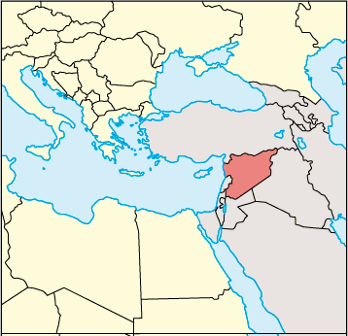What is the Capital of Syria? Damascus

Damascus is the capital of Syria. The city is located southwest of the country at 680 meters above sea level, at the foot of the Anti-Lebanon Mountains. The population of Damascus is difficult to estimate due to large numbers of migrants during the civil war in Syria that began in 2011. In 2009, the city had an estimated population of just over 1.7 million. Since the start of the war, Damascus has surpassed Aleppo in size due to the fighting there between 2012 and 2016.
The city is located in the fertile Ghutah oasis, formed by the river Barada that flows through the city, with rich crops of fruits, grains and other, in an otherwise very arid area. Damascus International Airport is around 20 kilometers from the city. A railroad leads to Aleppo in the north, Beirut in Lebanon and Amman in Jordan, but rail operations in the country have largely been halted as a result of the civil war.
Damascus has a long history as a cultural and trade center in the Middle East. The city’s industry includes, among other things, the production of furniture, textiles, clothing, footwear, cement and glass. The formerly important craftsmanship now has little significance. Damascus has several universities and colleges, where the medical education at the oldest, the University of Damascus, was founded as early as 1903 and the university was established in 1923, and is the seat of both the Melkite Patriarch and three archbishops. Also located in the city are the National Museum of Syria (1921) and the Arab Academy (1919), which houses the National Library.
Resorts
Although Damascus is one of the cities in the world that has had the longest continuous settlement, it has relatively few old buildings. The modern town plan was made by the French in 1929. Most striking is the old town, which is surrounded by a wall, originally Roman. Here are ancient buildings, narrow streets and numerous bazaars, such as the great Hamidiyah souk, and mosques, including the Omayyade Mosque of 705, which is one of the most sacred buildings of the Muslims. It was originally built as the Church of St. John by Emperor Theodosius (375) and his son on the site of an ancient temple. Other attractions include Saladin’s Mausoleum and the Citadel (dating back to the 13th century). The city is on UNESCO’s List of the world’s cultural and natural heritage. While downtown Damascus has remained largely untouched during the Civil War, other areas and suburbs have been hit harder, with some major destruction. However, Damascus has been one of the largest cities in Syria that has managed the best through the war.
History
In pre-Semitic times, Damascus was a major center of trade in Syria, at the intersection of the trade route from Mesopotamia to the Mediterranean and from Arabia to Northern Syria. Damascus is first mentioned in a list of cities conquered by Thutmosis 3 (around 1500 BCE). From the 9th century BCE was the capital of Damascus in an Aramaic kingdom. In the late 700’s, Damascus was conquered by the Assyrians, which made Syria an Assyrian province. The city was undergoing a new rise during the Persians when it became the center of worship of the Persian fertility goddess Anahita. Under Alexander the Great’s successors, selevkids, Damascus was initially shaded by the newly created capital, Antioch, but when the selevkids later moved the national center to Damascus, it regained its leadership position. At the beginning of our time, Damascus came for a time under the neighbors of Petra, but was again incorporated into the Roman province of Syria. Damascus remained so Roman until the Arabs in 635 occupied the city and surrounding area.
From 661 to 750 Damascus was the center of the Islamic world, with the Caliphs (Omayyads) living there. The city was once again in the background when the new Caliphs first settled in Baghdad, then in Cairo and finally in Baghdad again, until the Ottoman sultans in Constantinople took over the leadership of the Arab world in 1517. From that time Damascus came under Turkish rule and remained Turkish until after the First World War. After Syria became French mandate in 1920, Damascus became the capital of the Syrian federation in 1925. During the battles between French and Druze from 1925 to 1926, parts of the city were destroyed. Under World War II Damascus was occupied by British and Free French forces in 1941, and the independent republic of Syria proclaimed the same year.
The Civil War
After the civil war broke out as a result of the protests that began in 2011, parts of Damascus have been hit hard. From November 2011, a series of protests arose against the incumbent government led by President Bashar al-Assad. The protests were turned down by government forces, but in spring 2012 opposition to the regime took a different turn as rebels from surrounding areas entered the city. From 2012 to spring 2018, different parts of the city were under changing control between different rebels and government forces, and neighborhoods and districts have been bombed on a number of occasions. In 2015, Yarmouk, an area largely comprised of Palestinian refugees, was taken in by armed groups affiliated with IS and Jabhat al-Nusra. When Yarmouk again fell under the control of government forces in 2018, the population was sharply reduced. As of summer 2018, the city has again been under the control of government forces.














































